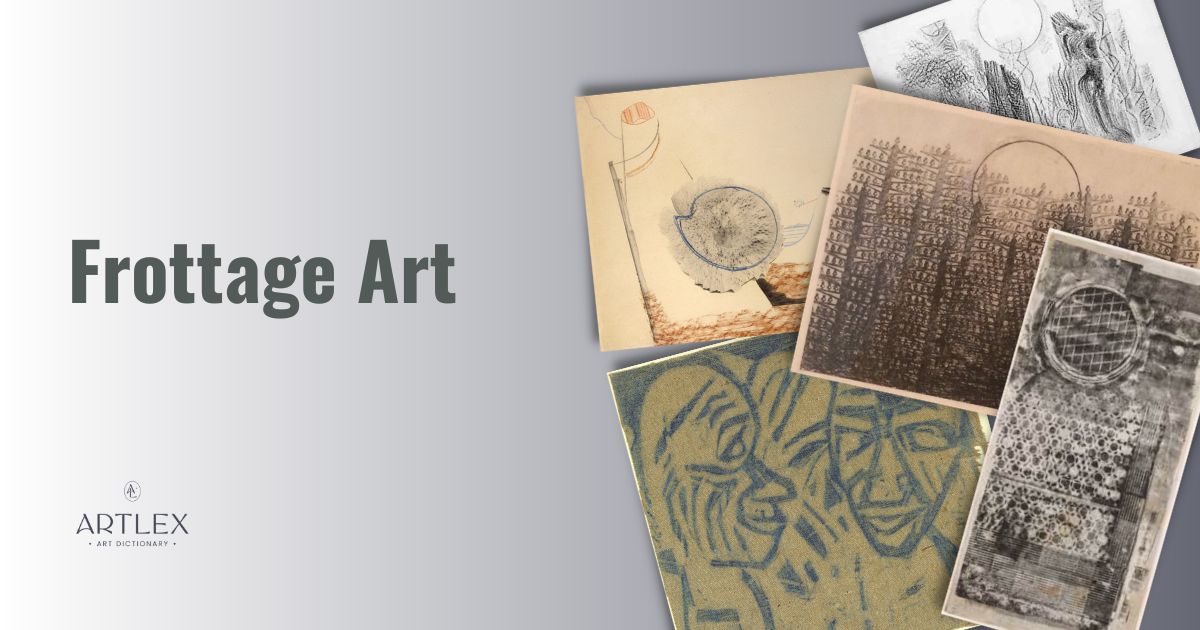What is Frottage Art?
Frottage is an artistic technique first adopted by the Surrealist artist Max Ernst in the second half of the 1920s. The frottage creative process is based on the principle of rubbing a sheet of paper or a canvas over a rough and textured surface, using a pencil, a crayon or other drawing tools. Frottage is one of the techniques invented by the Surrealist movement to perform automated gestures and to obtain works of art that imply randomness and a subconscious component, instead of a rational process.
The term frottage derived from the French verb frotter, which means “to scratch”, “to rub”, the procedure actually used by the artist. In fact, the result obtained by applying the frottage technique is an improvised pattern, which reflects the irregular surface on which the rubbing was carried out.
Examples of Frottage Artworks
https://www.moma.org/collection/works/37053?sov_referrer=art_term&art_term_slug=frottage, Forest and Sun, Max Ernst, 1931, Museum of Modern Art, New York
https://www.moma.org/collection/works/61117?sov_referrer=art_term&art_term_slug=frottage, Large Heads (2 Heads I) [Grosse Köpfe (2 Köpfe I)], Christian Rohlfs, 1921- dated 1933, Museum of Modern Art, New York
https://www.moma.org/collection/works/186612?sov_referrer=art_term&art_term_slug=frottage, Soho Sidewalk, Sari Dienes, 1953-1955, Museum of Modern Art, New York
https://www.centrepompidou.fr/es/ressources/oeuvre/5PthMeP, La forêt pétrifiée, Max Ernst, 1929, Centre Pompidou, Paris
https://www.guggenheim-venice.it/en/art/works/frottage/, Frottage, Roland Penrose, 1932 ca, Peggy Guggenheim Collection, Venice
https://www.andrebreton.fr/work/56600100208750, Frottage d’une médaille religieuse, André Breton, André Breton Collection, Paris
https://www.artsy.net/artwork/giuseppe-penone-verde-del-bosco, Verde del Bosco, Giuseppe Penone, 1986, Private Collection
https://www.moma.org/collection/works/65371?sov_referrer=art_term&art_term_slug=frottage, Whitney Murders, Louise Bourgeois, 1978, Museum of Modern Art, New York
History of Frottage Art
The frottage technique is performed by superimposing a sheet of paper or canvas on a surface with roughness and relief (e.g. a stone, a wooden surface, leaves, canvas sacks.) and rubbing it in with pencils, crayons, chalks or other drawing tools.
It was already commonly used in Ancient China and classical Greece, to obtain simple copies of bas-reliefs on rice or parchment paper but it was officially invented in the 20th Century, during the Avant-Garde movement of Surrealism. The pioneer of frottage art was the German naturalized American artist Max Ernst, who in 1926 made consistent use of this technique for the first time in Histoire Naturelle, his collection of nature-inspired drawings.
Ernst said that the inspiration for frottage came to him in 1925, while looking at the wooden floor of his house; the patterns of the graining communicated unexpected images to his mind; so, he decided to capture them by laying sheets of paper on the floor and rubbing over them with a pencil. From this intuition, Ernst obtained the first suggestions for the graphic cycle Histoire Naturelle (Natural History), creating irregular shapes which he then transformed into forests populated by mysterious creatures and birds.
Ernst was an innovator; in addition to the invention of frottage art, he was also responsible for the invention of the grattage technique, obtained by scraping fresh paint with a spatula, and for the dripping, obtained by pouring fresh paint directly onto the canvas, which was more commonly used later in Action Painting. In Frottage Art, the drawing obtained by the artist can be simply used reproducing the surface of the selected object, but it can also be the starting point to create other more elaborated images. Several artists start with frottage, adding details later to create more complex graphic textures.
The invention of frottage was a method for Surrealism to invent a painting technique that followed the principle of psychic automatism. The Surrealists, influenced by psychoanalysis, wanted to get in touch with the most unconscious part of their Self, so they used techniques that reduced the rational intervention of the artist to the minimum. In this way, in the Surrealist view, the frottage drawings represented a message from the unconscious. Its interpretation was a task that the artist had to undertake later. Frottage (like grattage and dripping) were painting techniques that followed the same principle as automatic writing, which the Surrealists used in poetry and literary field.
The frottage technique was extremely popular, apart from Ernst, among other Surrealist artists, like Michaux, Bréton, Penrose. However, it was also used in more contemporary times. The artist Giuseppe Penone, an exponent of Italian Arte Povera, often used the technique of frottage on trees bark, leaves and branches, to capture the essence of nature through a direct process. Frottage was also used by Sari Dienes, rubbing ink directly on Webril, Louise Bourgeois, Robert Indiana, Gabriel Orozco, and Mona Hatoum.
Notable Artists who used Frottage Technique
- Max Ernst, 2 April 1891 – 1 April 1976, German/American
- Christian Rohlfs, November 22, 1849 – January 8, 1938, German
- Henri Michaux, 24 May 1899 – 19 October 1984, Belgian/French
- Roland Penrose, 14 October 1900 – 23 April 1984, English
- André Breton, 18 February 1896 – 28 September 1966, French
- Sari Dienes, 8 October 1898 – 25 May 1992, Hungarian/American
- Giuseppe Penone, 3 April 1947; Italian
- Louise Bourgeois, 25 December 1911 – 31 May 2010, French/American
- Robert Indiana, September 13, 1928 – May 19, 2018, American
Related Art Terms
- Surrealism
- Dada
- Grattage Art
- Dripping
- Automatism
- Arte Povera
- Drawing Technique
- Graphic Art

